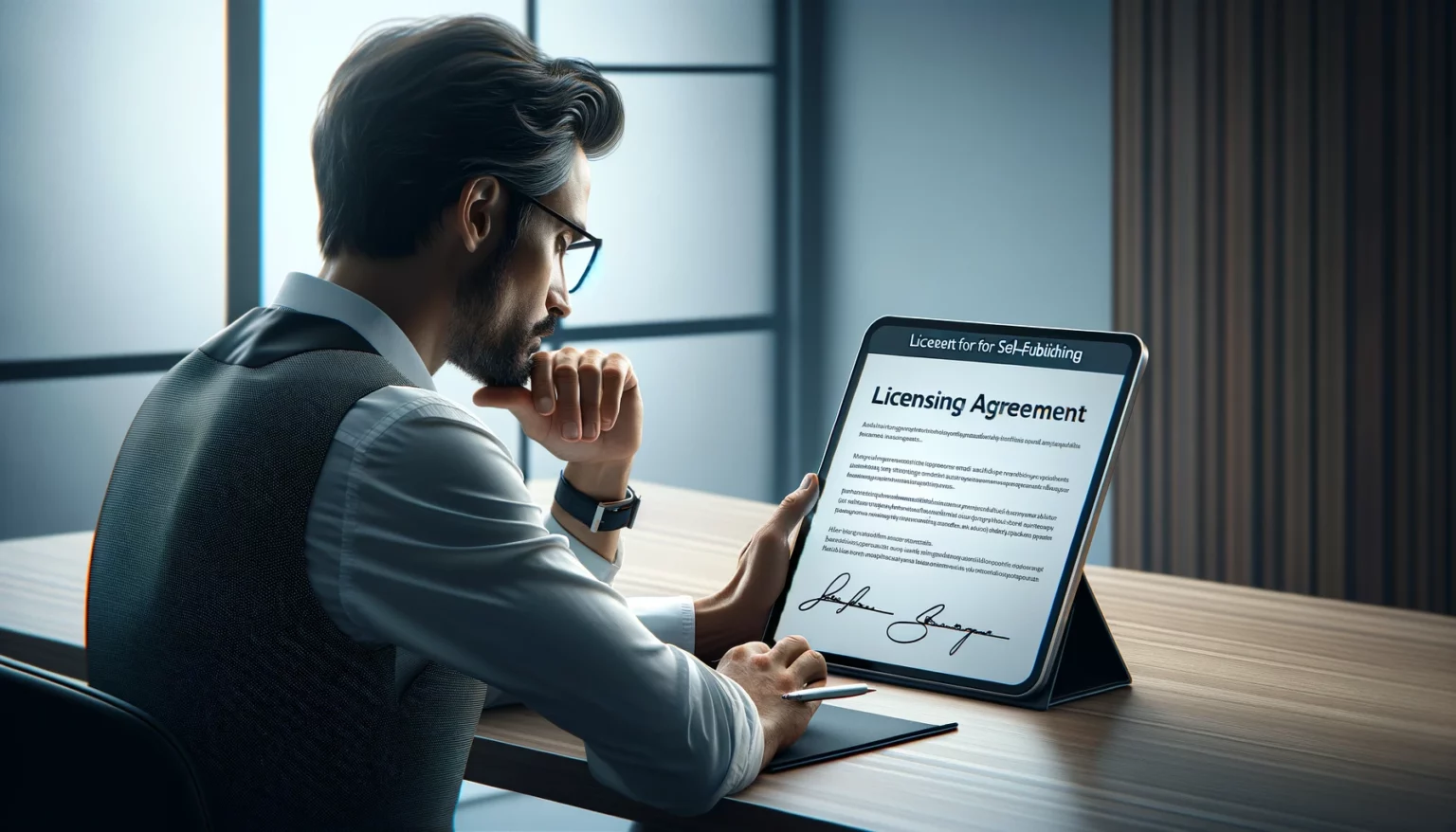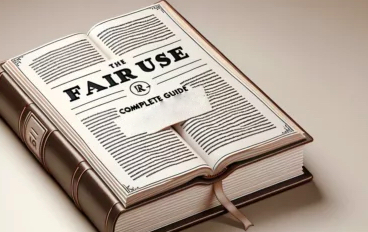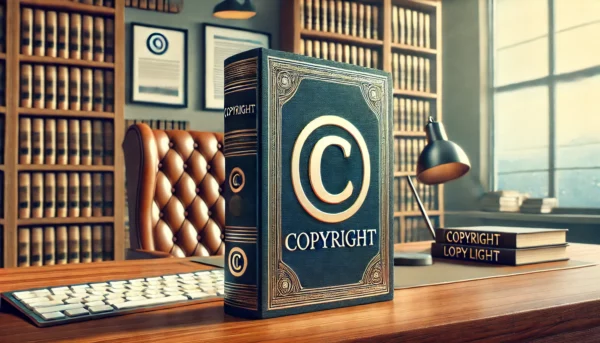In the rapidly evolving landscape of the publishing industry, self-publishing has emerged as a vibrant avenue for authors to bring their work directly to readers without the intermediation of traditional publishing houses. This democratization of publishing empowers authors with full control over the creative and distribution aspects of their work, from the initial draft to the final product gracing bookshelves and digital platforms. However, with this freedom comes a complex web of responsibilities, notably in understanding and managing the licensing of content.
At the heart of self-publishing lies the critical concept of intellectual property (IP), a legal framework that protects the creator’s rights to their work. Copyright law, an integral component of IP, grants authors exclusive rights to their creations, allowing them to reproduce, distribute, and display their work publicly. However, these rights are not absolute and are subject to limitations and exceptions, particularly when incorporating work owned by others. This is where licensing agreements come into play—legal contracts that authorize the use of copyrighted material under specific conditions, ensuring that authors respect and compensate the original creators.
This guide is crafted for aspiring self-publishers and seasoned authors alike, aiming to demystify the intricacies of licensing content within the self-publishing process. Whether you’re integrating external content into your manuscript, using artwork for your book cover, or adapting existing works, a solid grasp of IP, copyright law, and licensing agreements is indispensable. By equipping yourself with this knowledge, you not only safeguard your work against infringement but also uphold the integrity and legal standing of your publishing venture. Through this exploration, our goal is to empower you to navigate licensing content for self-publishing and guide you through the landscape confidently and conscientiously.
Understanding Intellectual Property in Self-Publishing
Intellectual Property (IP) rights serve as the cornerstone of the creative industries, including the realm of publishing. These rights are a set of legal entitlements that grant creators and owners control over their intellectual creations, ensuring they can benefit from their work. In the context of self-publishing, understanding IP rights is not just beneficial; it’s a necessity for safeguarding one’s work and respecting others’ rights.
Your Publishing Journey Awaits – Start NowIP rights in publishing primarily revolve around protecting the intangible assets that constitute a book or any published material. These assets can be broadly categorized into literary works, artistic works (such as illustrations and photographs), and sometimes even typographic arrangements. Literary works include novels, poems, plays, reference works, and other written creations. Artistic works relevant to authors and publishers encompass illustrations, cover designs, photographs, and maps that might be used within a publication. Each of these elements is protected by IP rights, provided they are original and fixed in a tangible medium of expression, ensuring that creativity and originality are duly rewarded and protected.
However, navigating IP in self-publishing is fraught with misconceptions that can lead to legal pitfalls. A common fallacy is the belief that anything available on the internet is free to use. This is far from the truth; in most cases, online content is copyrighted, and using it without permission can lead to copyright infringement. Another misunderstanding is the notion of “fair use,” which some self-publishers mistakenly believe allows them to use copyrighted material without permission. While fair use does exist, its application is highly specific and context-dependent, often requiring legal interpretation to avoid infringement.
Moreover, there’s a misconception that copyright only applies to works that are formally registered with a copyright office. In reality, copyright protection is automatic upon the creation of the work and its fixation in a tangible form. Registration, while not mandatory, can provide significant legal advantages, particularly in enforcing copyright and seeking statutory damages in case of infringement.
Understanding the nuances of IP rights enables self-publishers to not only protect their own creations but also to navigate the complexities of using third-party content within their works. For instance, incorporating an existing photograph or illustration into a book cover requires permission from the copyright holder, typically through a licensing agreement. Similarly, quoting or adapting copyrighted material within the text demands a clear understanding of copyright law to ensure compliance and avoid legal issues.
In summary, IP rights are a vital component of the self-publishing process, providing a framework for the protection and lawful use of creative content. By dispelling common misconceptions and gaining a solid understanding of IP, self-publishers can avoid legal pitfalls, respect the rights of fellow creators, and secure their own works against unauthorized use. This foundational knowledge not only fosters a more ethical and legally sound publishing environment but also empowers authors to confidently navigate the complex landscape of self-publishing.
Navigating Copyright Law for Self-Publishers
Copyright law is a critical framework within which self-publishers operate, designed to protect the rights of creators by granting them exclusive control over their original works. For self-publishers, this means having the legal right to reproduce, distribute, sell, and display their works, as well as to prepare derivative works based on the original. Understanding how copyright law applies to self-published content is essential for navigating the publishing process successfully and lawfully.
A fundamental concept in copyright law is the requirement for a work to be in a “fixed form.” This means that the work must be expressed in a medium that is sufficiently permanent or stable to permit it to be perceived, reproduced, or otherwise communicated for a period of more than transitory duration. For writers, this includes manuscripts, printed books, and eBooks, ensuring that literary creations are protected once they are written down or saved in a digital format.
Another cornerstone of copyright law is the notion of “original work.” For a work to be copyrightable, it must be original, meaning it was independently created by the author and possesses at least a minimal degree of creativity. This does not mean the work has to be novel or unique, but it should not be a direct copy of someone else’s work. This distinction is crucial for self-publishers, especially when incorporating elements such as common phrases, facts, or ideas that are not protected by copyright.
Copyright ownership is automatically vested in the creator of the work from the moment it is fixed in a tangible form. For self-published authors, this means they hold the copyright to their work as soon as they write it. However, it’s important to formalize this ownership through a copyright page in the book, a title page that typically includes the copyright symbol (©), the year of first publication, and the name of the copyright owner. This copyright page serves as a clear assertion of copyright and can deter infringement.
Though not a legal requirement, copyright registration is highly recommended for self-publishers. Registering a copyright with the appropriate governmental body, such as the U.S. Copyright Office, provides a public record of the copyright and is necessary for filing infringement lawsuits in federal court. It can also increase the potential statutory damages and attorney’s fees recoverable in case of infringement.
Copyright infringement occurs when someone uses a copyrighted work without authorization in a way that violates one or more of the copyright holder’s exclusive rights. For self-publishers, common risks include unauthorized reproduction of their work, creation of derivative works without permission, and distribution of copies without consent. To avoid infringement, self-publishers should be diligent about securing permissions for any third-party content they wish to include in their work, whether it’s text, images, or other media. This often involves negotiating licensing agreements that clearly outline the terms of use.
Moreover, self-publishers and independent publishers should be mindful of the fair use doctrine, which allows limited use of copyrighted material without permission under certain conditions, such as for commentary, criticism, news reporting, teaching, scholarship, or research. However, fair use is a complex legal doctrine subject to interpretation, and reliance on it should be approached with caution and, ideally, legal advice.
In conclusion, navigating copyright law is a vital aspect of self-publishing, requiring authors to understand the protections it affords to their work and the obligations it imposes regarding the use of others’ work. By grasping the concepts of fixed form, original work, copyright ownership, and the mechanisms for protecting and enforcing copyright, self-publishers can safeguard their creative endeavors and navigate the publishing landscape with confidence and legal compliance.
Licensing Agreements Explained
Licensing agreements are pivotal in the realm of publishing, serving as legally binding contracts that grant permission to use copyrighted material under specific conditions. For self-publishers, understanding and effectively navigating licensing agreements is essential for incorporating third-party content into their works, be it text, images, or other forms of media, and for negotiating the rights to their own work with other publishers and entities.
Your Publishing Journey Awaits – Start NowThe essence of a licensing agreement in publishing is to delineate the terms under which copyrighted material can be used. These agreements are crucial because they ensure that creators and copyright owners receive fair recognition and compensation for their work, while also providing a legal framework for the use of their creations. This balance fosters a healthy ecosystem where creativity is protected and rewarded, allowing for a wide dissemination of ideas and information.
Licensing license agreements can vary significantly in their specifics, but they generally fall into a few broad categories:
1. Exclusive vs. Non-Exclusive Agreements: An exclusive license grants the licensee the sole right to use the copyrighted material in only the right manner specified by the agreement. This means the licensor cannot grant the same rights to other parties or use the rights in a competing manner themselves. In contrast, a non-exclusive license allows the copyright owner to grant the same or similar rights to multiple parties in various ways, including retaining the right to use the copyrighted material.
2. Creative Commons (CC) Licenses: CC licenses are a set of copyright licenses that enable copyright owners to grant certain usage rights to the public while retaining others. These licenses range from the most permissive (CC BY, which only requires attribution) to the most restrictive (CC BY-NC-ND, which allows others to download the works and share them with others as long as they credit the author, but they can’t change them in any way or use them commercially). CC licenses are particularly popular in digital publishing and open-access resources, allowing for a predefined and standardized way of sharing creative work.
3. Standard Contracts: These are more traditional licensing agreements that are often negotiated between two parties and tailored to their specific needs and circumstances. A standard contract can cover a wide range of uses and stipulate very specific terms regarding the rights being licensed.
Regardless of the type, several key components are usually present in licensing agreements:
- Scope of Rights: This defines what rights are being licensed out, such as the right to reproduce, distribute, sell, or modify the work. It might also specify the formats in which the work can be used (e.g., print, digital, audio).
- Duration: The agreement will specify how long the licensee can use the rights. This can range from a limited period (e.g., one year) to in perpetuity.
- Territory: This indicates the geographical area in which the rights can be exercised. It could be as narrow as a single country or as broad as worldwide.
- Financial Terms: This section outlines any fees, royalties, or other financial compensation the licensee must provide to the licensor in exchange for the rights being granted.
- Usage Restrictions: These are any specific limitations or prohibitions on how the licensed material can be used, such as restrictions on modifying the work or restrictions on using the work in certain contexts or markets.
- Termination Conditions: The agreement will specify under what conditions the agreement can be terminated by either party and what happens to the licensed rights upon termination.
Understanding these components and their implications is crucial for self-publishers, whether they are licensing content from others or licensing their own content out. Properly negotiated and drafted licensing agreements ensure that all parties are clear on their rights and responsibilities, helping to prevent disputes and ensuring that everyone involved is fairly compensated and credited for their contributions. For self-publishers, this knowledge is not just legal protection—it’s a fundamental aspect of professional and ethical publishing practices.
Working with Traditional Publishers and Other Platforms
The landscape of publishing has significantly evolved, allowing self-publishing authors to explore diverse avenues for distributing and monetizing their work. This includes not only direct-to-consumer sales but also engaging with traditional publishers and various digital platforms. Navigating these relationships and understanding the licensing terms involved is crucial for maximizing the reach and profitability of one’s work.
Relationship with Traditional Publishers
Self-publishing authors sometimes view traditional publishers as a separate or competing route, but in reality, the two can complement each other. Traditional publishers offer expertise in distribution, marketing, and access to broader markets that might be difficult for self-publishers to penetrate independently. They also bring a level of prestige and validation to a book, which can be beneficial in certain genres or markets.
A common intersection between self-publishing and traditional publishing is through subsidiary rights. These rights include options for translations, audiobooks, film or TV adaptations, and more. Self-published authors who retain their subsidiary rights can license them to traditional publishers or production companies, potentially opening additional revenue streams. Negotiating these rights requires a clear understanding of their value and the long-term implications of any agreements.
Subsidiary Rights and Licensing
Subsidiary rights are specific rights derived from the primary right to publish a book. They can be lucrative and significantly extend a book’s reach and impact. Self-publishing authors should be mindful of these rights and consider them when entering any contract or agreement. Licensing these rights to traditional publishers can be complex, involving negotiations on scope, duration, territory, and compensation.
Authors should be particularly cautious not to sign away rights unnecessarily, especially in a standard publishing contract where a traditional publisher might ask for broad rights as part of the deal. It’s crucial to negotiate favorable terms and to retain as much control over one’s work as possible, especially over rights that the publisher has no concrete plans to exploit.
The Role of Digital Platforms
Digital platforms like Amazon Kindle Direct Publishing, Smashwords, and Draft2Digital have revolutionized self-publishing, providing tools and marketplaces for authors to publish, distribute, and sell their books with unprecedented ease. These platforms operate under their own set of licensing terms, which authors must adhere to when publishing their work.
For instance, Amazon’s KDP Select program offers higher royalties and promotional opportunities in exchange for exclusivity, meaning the digital version of the book can only be sold through Amazon for a certain period. This can be a significant commitment and may limit an author’s ability to distribute their book through other channels.
Platforms like Smashwords, on the other hand, offer a non-exclusive distribution model, allowing authors to retain more control over where and how their books are sold. However, each platform has its own royalty structure and terms of use that can affect an author’s earnings and rights.
Navigating Licensing Terms
When working with these platforms, it’s essential to understand the licensing terms thoroughly. This includes understanding the rights you’re granting to the platform, the duration of those rights, any exclusivity clauses, and how and when you can terminate the agreement. It’s also important to understand how these terms interact with any other agreements you might have, such as those with traditional publishers or agents.
For self-publishing authors, the key is to maintain as much control over their work as possible while exploiting various channels to maximize exposure and revenue. This might involve a mix of exclusive and non-exclusive agreements, tailored to the specific strengths and opportunities of each platform or publisher.
Your Publishing Journey Awaits – Start NowIn conclusion, the relationship between self-publishing authors, traditional publishers, and digital platforms is multifaceted and requires careful navigation. Understanding and strategically managing subsidiary rights, along with the specific licensing terms of each publishing avenue, are crucial steps in maximizing the potential of one’s work while retaining control and flexibility.
Best Practices for Licensing Content as a Self-Publisher
Licensing content is a critical business aspect of self-publishing that requires careful attention to detail and a proactive approach. Whether it’s sourcing images for book covers or incorporating copyrighted material into your work, understanding how to navigate the licensing landscape is key to ensuring your project’s legality and success.
Identifying Content that Needs to be Licensed
The first step is to identify which elements of your project require licensing. Common areas include:
- Images for Book Covers: The cover is often the first point of contact between your book and potential readers, making it crucial to have an eye-catching design. If you’re using stock images or artwork created by someone else, ensure you have the appropriate licenses to use these images commercially.
- Copyrighted Material for Derivative Works: If your work is inspired by or directly uses parts of existing copyrighted materials, such as excerpts from other books, songs, poems, or any other form of creative work, you’ll need permission from the copyright holder to use these elements in your work.
- Illustrations and Photographs within the Book: Similar to cover images, any external illustrations, photographs, or artwork used within the book need to be properly licensed for your use.
Tips on Negotiating Licensing Agreements
Negotiating licensing agreements can be daunting, but these tips can help you decide to secure the rights you need on favorable terms:
- Seek Professional Advice: Consider consulting with a legal professional who specializes in intellectual property law. They can provide valuable insights into the terms of an agreement and help you understand your rights and obligations.
- Understand the Value of Your Work: Have a clear understanding of the worth of your work and the content you’re licensing. This knowledge will empower you to negotiate terms that reflect the value of the content you’re using or offering.
- Be Clear on Terms: Ensure you’re clear on the scope of the license, including rights, restrictions, duration, and territory. This clarity will prevent misunderstandings and potential legal issues down the line.
- Bargain for Better Deals: Don’t be afraid to negotiate terms. If you’re licensing content from others, consider asking for more favorable rates or terms. If you’re licensing your own work, push for terms that respect the value of your creation.
Managing Multiple Licenses and Permissions
Managing multiple licenses and permissions for a single project can become complex. Here are strategies to keep everything in order:
- Maintain Organized Records: Keep detailed records of all licenses and permissions, including the scope of the license, duration, and any specific terms or conditions. This will help you track your obligations and ensure compliance.
- Use License Management Software: Consider using license management software to track the status of various licenses, renewal dates, and compliance requirements. This can be especially useful for projects with multiple licensed elements.
- Regularly Review Licenses: Periodically review your licenses to ensure they are still valid and that you’re in compliance with their terms. This is particularly important for long-term projects or works that are re-published or adapted over time.
- Plan for Renewals and Expirations: Be aware of any license renewals or expirations. Plan ahead to renew licenses as needed or to find alternative solutions if a license cannot be renewed.
- Communicate with Licensees: Maintain open lines of communication with those you’ve licensed content from. This can help resolve any issues that arise and facilitate negotiations for renewals or changes to the licensing agreement.
By adhering to these best practices, self-publishers can navigate the complexities of licensing content with confidence. Proper licensing not only ensures the legality of your work but also respects the rights of other creators, contributing to a fair and vibrant creative ecosystem.
Simplify with Artificial Intelligence (AI)
In the digital age, artificial intelligence (AI) is revolutionizing the way self-publishing authors approach copyright licensing. AI technologies can simplify the process by automating the search for copyright owners, analyzing licensing agreements for complex terms, and even suggesting fair pricing models based on market data. This innovation significantly reduces the time and effort required to secure necessary permissions, making it more accessible for authors to protect and monetize their work.
A prime example of AI’s impact on the publishing world is Spines, a forward-thinking publishing platform that harnesses AI to assist authors in navigating publishing, including the intricacies of copyright and licensing. Spines offer a copyright tool, which typically costs between $50 and $120, completely free of charge. Simply sign up with a few clicks to get your copyright protection for free.
Your Publishing Journey Awaits – Start NowConclusion
In navigating the intricate world of self-publishing, understanding and managing licensing content emerges as a fundamental aspect, pivotal to both the success and legality of your publishing endeavors. This guide has traversed the critical terrains of intellectual property rights, copyright law, the nuances of licensing agreements, the dynamics between self-publishing authors and traditional publishers, and the indispensable best practices for licensing content.
The essence of intellectual property rights in safeguarding your creative output cannot be overstated, serving as the backbone for protecting and monetizing your work. Copyright law, with its emphasis on original work and fixed form, provides a legal framework that ensures your creations are rightfully yours, while also guiding you on how to respect others’ works. Licensing agreements, whether exclusive or non-exclusive, are the vehicles through which you navigate the use of copyrighted material, ensuring that all parties’ rights are recognized and compensated.
Engaging with traditional publishers and leveraging digital platforms like Amazon and Smashwords highlight the multifaceted business nature of self-publishing today. These avenues offer unique opportunities and challenges, particularly when it comes to understanding and negotiating subsidiary rights and platform-specific licensing terms.
As you forge ahead on your self-publishing journey, the imperative to continuously educate yourself on the evolving landscape of intellectual property and licensing cannot be understated. This knowledge not only protects your work but also empowers you to make informed decisions, fostering a creative environment where your work can thrive and reach its fullest potential. Embrace this learning curve as an integral part of your journey, for it is through understanding the intricacies of licensing that your work will truly flourish in the vast world of publishing.








